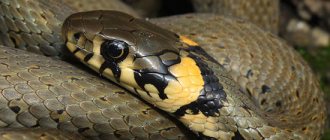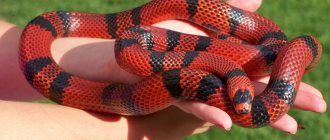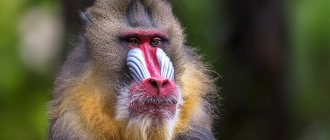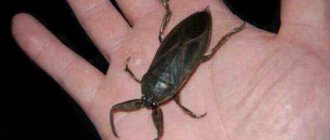- Wild animals
- >>
- Reptiles
Various reptiles rarely inspire sympathy. However, we are definitely not talking about the tiger snake. This animal has been very popular among exotic lovers since the sixties. The tiger snake is a brightly colored reptile with an easy-going and friendly character. For a very long time she was considered an absolutely harmless creature, but this turned out not to be the case. You can learn more useful and interesting facts about the tiger snake from this publication.
Origin of the species and description
Photo: Tiger snake
The tiger snake is a very common species of snake, part of the huge family Colubridae. It is a member of the long-toothed snake genus, which includes nineteen species of different reptiles. And only one species lives on the territory of Russia, in particular in Primorye and Khabarovsk Territory.
Video: Tiger snake
The tiger snake has a peaceful nature, so it is easily tamed and can be kept at home. For a very long time, this reptile was considered safe, and only in 2008 were scientists able to find out that such a reptile could cause significant damage to human health. During the research, we learned that the neck glands of a snake accumulate toxins. This happens when the animal feeds on poisonous amphibians. Such information has certainly reduced the number of fans of the tiger snake.
Interesting fact: Accumulating poison in itself, it changes its habits. From a calm, balanced creature, he turns into a rather aggressive reptile. He no longer hides from predators or his other offenders, but begins to fight back, biting the victim. Such bites lead to serious poisoning in the attacker.
Recognizing a tiger snake in the wild is not that difficult. This is a relatively small snake, whose body length reaches about one meter. A distinctive feature is the bright color. The upper part of the animal's body is painted bright green and decorated with dark stripes. The neck and front part of the body are red-orange in color. It is on this basis that this reptile is similar to a representative of the felines and received its name “Tiger Snake”.
Unlike most reptiles of the colubrid family, the tiger snake very quickly adapts to living in captivity. She is unpretentious and does not need a large “home”. A medium-sized terrarium is enough for her to live. The terrarium must be landscaped, equipped with branches for climbing and equipped with several shelters inside where the animal can hide from prying eyes.
Peculiarities of tiger snake behavior
Tiger snakes overwinter in abandoned rat-like rodent burrows or underground cavities, forming aggregations of several hundred snakes.
They react to danger by raising their upper body vertically. This flat-neck defensive stance is similar to the hood-opening cobra stance.
In addition, tiger snakes throw their bodies towards the enemy, accompanying these body movements with a loud hiss. The caustic substance produced by the nucleodorsal glands irritates the mouth of the predator, which immediately leaves its prey. However, tiger snakes are not such harmless snakes and can bite themselves, but the short teeth usually do not penetrate too deeply and the poison does not enter the bloodstream. But if the skin is scratched by the long back teeth, hidden deep in the mouth, the poison enters the bloodstream and causes severe poisoning of the body.
Tiger snakes can bite themselves.
Appearance and features
Photo: Tiger snake in nature
The tiger snake has several characteristic external features:
- relatively small dimensions. The length of such a reptile only rarely exceeds one meter. The length of the tail is about thirty centimeters. The physique is slender, like other members of the family;
- small head. It is slightly separated from the rest of the body. However, the cervical interception is mild. The eyes are medium in size, vision is very good, the pupil is round. The iris of the eyes is golden yellow. Blackening is visible only from the front and back;
- strong jaw. Like other snakes, the tiger snake is endowed with a powerful, flexible and elastic jaw. The teeth are sharp. The last two teeth, located in the upper part of the oral cavity, differ significantly from the rest in their size. They are enlarged, slightly curved, separated from other teeth by a gap;
- bright and interesting color. The back of such snakes is characteristically bright green with dark stripes. However, in nature there are other color options: dark olive, dark green, light brown. It is extremely rare to find adults with a purely black or blue back. The red edges of the scales are visible between the dark stripes on the back. There are black spots on the sides of the head;
- the middle of the body is covered with scales. Their number usually does not exceed nineteen pieces. The scales at the end are colored red;
- The tiger snake has many scutes: abdominal, subcaudal, pre- and postorbital.
Interesting fact: Many colubrids undergo various mutations at birth. The tiger snake is no exception. Sometimes such reptiles are born with two heads. However, the life expectancy of such unusual animals is very short.
Tiger snake
Description of the species
Long-toothed snakes (Rhabdophis) are snakes from a genus of bright, colorful and extremely interesting reptiles, modest in species diversity, whose distribution range is the mainland of Southeast Asia and the adjacent islands. The genus contains about 23-25 species, four of which are found in the Philippines, two inhabit the floodplain forests and lowlands of Sri Lanka and India, four species live in Malaysia. The rest are more widespread, but only one species of long-toothed snakes - the tiger snake - reaches the northern border of its zone distribution within Russia. This beautiful and very interesting representative of the family in its content and behavior will be discussed in this article. Keeping reptiles Aquarium salons Online pet supply stores Pet stores
The tiger snake is a slender snake, reaching more than a meter in length; there have been specimens up to one hundred and thirty centimeters long. The external structure of the head and body is similar to real snakes. Under the skin of the back, behind the head, it has from 10 to 19 pairs of nucho-dorsal glands, visible from the outside by small ridges on the skin. Scales with pronounced longitudinal ribs. The eyes are large, the pupil is round. In the mouth, the last two maxillary teeth are greatly enlarged, bent back and separated from the remaining teeth by a clear gap. Of the total number of snake tribes, the tiger snake is one of the most beautiful, and, of course, the most elegant of the snake species found in Russia. In terms of beauty and habits, only the dinodons living in the neighborhood and, perhaps, the leopard snakes, which are not very closely related, can compete with it. In nature, snakes are most often found with a color of dark green, dark olive, light brown; Along this background there are usually clearly defined black transverse stripes, sometimes divided into transverse dorsal and lateral spots. In the front part of the body, in the spaces between the stripes, the edges of the scales are bright red or orange-red. These orange and red spots only appear on adults. On the sides of the head there are two bright black spots: one is located in the temporal region, the other, triangular, connects the lower edge of the eye with the upper jaw. In fairness, it should be noted that sometimes, one might even say rarely, and mostly this is a lucky coincidence, snakes with a blue or black color come across, but this is a very pleasant exception for the finder. Tiger snakes are widespread in Korea, Eastern China and the Japanese Islands. In Russia, the habitat is limited only to the Far Eastern region - Primorye and the south of the Khabarovsk Territory. Here the snake is found in places with a constant level of humidity, preferring to stay near bodies of water, in swamps or in damp lowlands with dense vegetation. Far from water bodies, it settles in mixed and deciduous forests, as well as in meadows. In such places the species is quite numerous; You can find up to fifty specimens in an area of one square kilometer. For the winter, it goes into short-term hibernation, hiding in rodent burrows, in small crevices, under stones, snags, fallen trees, or in vast underground chambers that serve for the collective wintering of Far Eastern snakes.
When meeting a person, a tiger snake tries to quickly crawl away, but if this fails and the snake senses danger, it vertically raises the front part of its body, while its neck becomes flat, like a cobra’s unfurling its hood.
The defender hisses and lunges towards the enemy. The nucho-dorsal glands secrete a caustic secretion, which, when it gets into the mouth of a predator who has carelessly grabbed a tiger snake, forces it to immediately release the prey. On occasion, a tiger snake can itself bite an enemy. Its saliva is poisonous, but its short teeth usually do not bite deep enough into the human body for the poison to enter the bloodstream. However, if the grass snake manages to bite with its long back teeth, located deeply, severe poisoning can occur, accompanied by the same symptoms as with a viper bite. This family of snakes does not have true, that is, phylogenetically derived from the upper jaw, venom glands, but in the process of evolution they acquired the Duvernois gland, anatomically developed from the salivary gland. The secretion of this gland also has a poisonous effect, but less pronounced than that of other types of snakes. When keeping a tiger snake at home, you should know and follow a few simple rules:
1. The snake belongs to the family of long-toothed snakes, which have toxic saliva and two enlarged teeth hidden in the depths of the mouth; when bitten, the body can be poisoned, similar to the effect of viper venom. 2. This snake is similar in its biology and conditions of detention to real snakes, only its temperature should be slightly higher (28-30°C). Like the common snake, the tiger snake easily reproduces in captivity; wintering, although desirable, is not required. Depending on the duration and timing of wintering, the mating dates can be shifted to any month of the year, but usually it is February-March. The duration of pregnancy is 48 days. The second clutch from snakes can be obtained in June-July. The number of eggs in clutches ranges from 8 to 22, their dimensions are usually 27-35 mm x 16-20 mm, with a weight of about 20 g. The duration of incubation of eggs at a temperature of 27-30 ° C and 90% humidity is 34-38 days . The young hatch with a body length of 150-200 mm. Their first molt occurs a week after birth. The young grow quickly and at one year of age begin to show signs of sexual activity, and at 18 months they become sexually mature.
Like the common snake, the tiger snake is a true “frog-eater”; it feeds mainly on black-spotted and Far Eastern frogs, as well as toads and other tailless amphibians. However, it can also eat fish. Snakes should be fed separately, since when kept together, cases of “fights” for the food object quite often occur, and since snakes overtake and grab prey in a quick rush, it may well happen that, along with the frog, the hungrier tiger snake will begin to swallow and their fellow tribesmen. Having grabbed a toad, frog or other small animal, it begins to chew, as it were, the part of the victim’s body captured in its mouth, trying to put its enlarged poisonous teeth into action. Tiger snakes are quite voracious snakes, so when feeding them, the “golden rule” is best suited: it is better to underfeed than to overfeed, especially since in nature, unlike in terrarium keeping, the snake does not complete every hunt successfully. Therefore, it is quite advisable for a pet to follow a kind of diet: during the period of intensive growth of snakes, up to about six months, they should be fed more often - 2-3 times a week; after seven months, two or three feedings per month are quite enough, and it is advisable to give them along with feed vitamin preparations and calcium supplements, a wide selection of which is available in pet stores. Vitamins and mineral supplements have proven themselves very well, which include a complete balanced complex of substances and minerals necessary for the animal’s body. The tiger snake is a medium-sized snake, quite unpretentious in maintenance, so when kept, it may well be content with a medium-sized horizontal type of terrarium; it is advisable to arrange several secluded shelters, a small pool and several branches for climbing. Plants are desirable, but not required; to avoid breakage of stems or leaves, it is best to use plant species with strong stems and leaves, or creeping species - mosses, tradescantia, philodendrons, bromeliads. For decorative purposes, it is very good to plant part of the pool with aquatic plants - salvinia, riccia, and some other floating species. In general, the arrangement of a terrarium for your pet, its interior design is a matter of taste for the owner, but we must not forget that the main thing is the combination of beauty in the design and comfortable living of the animal, since “we are responsible for those we have tamed.”
The tiger snake is a “conditionally poisonous” snake
The tiger snake belongs to the group of “conditionally poisonous” snakes, that is, its poisonous teeth are located not in front, but deep in the mouth.
Unlike many other poisonous snakes (vipers, copperheads, etc.), the poisonous teeth of the tiger snake are located behind, at the rear edges of the upper jaw and are separated from the others by a toothless gap. Therefore, a bite with these teeth is not always applied even in the case of successful throws on the enemy. Since the teeth are located deep in the mouth on the posterior edge of the maxillary bone, the tiger snake can only bite the victim in the mouth. All this must be taken into account by terrariumists. Snakes typically feed on lizards and frogs, injecting them with poison as they ingest them. Although tiger snakes do not pose a direct danger to humans, since a normal bite uses only the non-venomous teeth located in front, if a bite with poisonous teeth does occur, typical snake venom poisoning occurs, sometimes with fatal consequences. For a long time, this snake in Russia was considered, and is still considered, non-venomous, since the snake is extremely calm and friendly, even during feeding, having entered into the excitement of the hunt, it perfectly sees and understands what can be eaten and what cannot, and does not try to attack the hand person. However, it should be noted that in Japan, statistics on poisoning by its poison have long been kept, and deaths are known, therefore, when keeping a tiger snake in an apartment, you should not forget that it is some kind of snake, but still a snake with its own complexes and reflexes , laid down by nature. Therefore, do not try to train her, but accept her for who she is, and she will give you many pleasant moments of rest and relaxation after a busy day at work. Alexander Repin, photo by [email protected]
Where does the tiger snake live?
Photo: Tiger snake
The natural habitat of snakes includes almost the entire mainland of Asia and the islands adjacent to the Southeast. They are common in the Philippines, India, Sri Lanka, and Malaysia. Also, separate populations are found in Russia, Eastern China, Korea and the Japanese Islands.
The tiger snake is very selective in choosing a place to live. It requires a special climate and suitable environmental conditions. This type of snake does not like too high or low temperatures. It is suited to a temperate climate with high humidity. These snakes choose territories located near bodies of water. They live preferably in forests, but sometimes snakes are also found in treeless areas. However, in the latter case, succulent vegetation must be available.
Tiger snakes are also found near sea coasts, in mixed forests, damp meadows, and near swamps. In such an area the population of snakes is very large. Sometimes up to forty adult individuals can be found within just a few kilometers. If in the warm season tiger snakes spend almost all their time on the surface of the ground, then in winter they cannot be seen. Such reptiles prefer to overwinter in abandoned rodent burrows and crevices. Wintering is always collective. Several individuals gather in one secluded place and hibernate. This helps them stay warm.
Habitats of the tiger snake
The tiger is already taking root in humid habitats. Choose areas near swamps, ponds, wet plains with thick grass cover. In the absence of water bodies, it inhabits deciduous and mixed forests, as well as wet meadows. In these parts this species of reptile is quite numerous and widespread; Up to 44 individuals were caught at a constant distance of 3 km.
In defense, the brindle already takes a characteristic pose.
What does a tiger snake eat?
Photo: Tiger snake
Tiger snakes are excellent hunters. These snakes are distinguished by good maneuverability and mobility. If necessary, they can almost instantly overcome long distances and various obstacles. Snakes can hunt on steep banks and even in trees. Tiger snakes are also excellent swimmers. They can search for food at a distance of several kilometers from the coast.
The tiger snake's diet is based on tailless amphibians.
In particular, these are:
- grass frogs;
- sharp-faced frogs;
- green frogs;
- gray toads;
- green toads;
- tree frogs.
Less commonly, the diet includes small fish: crucian carp, roach, chub. In addition, he will never refuse to feast on small lizards, small mice, shrews, voles, swallow chicks, larks, vipers, and young squirrels. To track and catch its next victim, a snake sometimes has to spend a lot of time waiting.
Interesting fact: Snakes hunt only at certain times of the day - morning or evening. This is due to the characteristics of the life of amphibians, which make up ninety percent of the diet. At such times, amphibian activity is very low and it is easier to catch them.
When snakes catch their prey, they do not strangle or kill it. The snakes swallow her whole and alive. From the outside, the process looks daunting. The tiger snake seems to “suck” the animal with its mouth, gradually pulling its jaws onto it. If the prey is small in size, then swallowing it whole is not difficult. The hardest thing is when there is a large amphibian for dinner. A snake can fiddle with it for several hours in a row. It sucks large amphibians from their hind legs so that all the excess air can be expelled from the victim in the process.
Features of character and lifestyle
Photo: Tiger snake in Russia
The tiger snake is an animal that leads a semi-aquatic lifestyle. It can stay on land and in water for the same length of time. However, snakes still prefer to spend more time on land. During the day, these reptiles are inactive. Most often, they spend their time in dense thickets, under the roots of a tree in the forest, or in strange burrows that have been left by other animals. Sometimes you can see these small snakes during the day, when the air temperature warms up and the sun is shining in the sky. In this case, tiger snakes can be seen in the open space near the shore, on a wooden pier. In such places, the reptiles love to bask in the sun.
The reptile crawls out to hunt only at dusk or early in the morning, when amphibians are not so careful and active. Snakes hunt with the help of excellent vision and charm. They are almost silent, quickly find a suitable victim in the dark and deftly swallow it whole. The tiger snake is very careful, never in a hurry, so the hunting process can take a long time.
The activity of tiger snakes always depends on the ambient temperature. These animals love warm climates and are always active in sunny weather. When air temperatures drop, snakes become less vigilant, become passive, and may not even react when predators get close enough to them. If the snake is unable to crawl away from danger, it takes a special defensive position. The tiger snake raises the front part of its body upward, hisses menacingly and rushes towards the attacker. In other cases, these snakes do not show aggression; they are quite peaceful and calm in nature.
Social structure and reproduction
Photo: Tiger snake
The mating season for these reptiles begins immediately after spring awakening. In the southern part of their natural habitat, such snakes begin to mate quite early - at the end of February or at the beginning of March. In other territories, the mating season occurs in late spring or early summer. After mating, females carry their young for about forty-eight days. At this time, they try to feed more on poisonous frogs. This allows them to accumulate enough toxins. Pregnant females spend almost the entire day in the forest, where many poisonous amphibians live.
Why do they need toxins? The thing is that small snakes cannot swallow a frog on their own, so they take the poison directly from the mother. This increases the survival rate of offspring. In the southern regions, females lay eggs already at the beginning of May, in another part of the natural habitat - at the end of August. At one time, the female can lay from eight to twenty-two eggs. Each egg weighs approximately twenty grams.
Eggs require fairly high temperatures and high humidity to develop. If the conditions are met, then within four to five weeks the uglies are born. When hatching, their length does not exceed two hundred millimeters. The constrictors first feed on small insects, then their prey becomes larger and more nutritious. Children of tiger snakes grow and develop very quickly. Already at one and a half years they are considered sexually mature.
Keeping a tiger snake in a terrarium
The conditions for breeding tiger snakes in captivity are the same, as are the features of breeding common snakes. The temperature in the terrarium is maintained within 28-30 degrees. Reptiles reproduce well in captivity, possibly without wintering, although experts recommend not disturbing the natural cycle of snakes. Mating usually occurs in February or March, but may occur later if wintering is prolonged.
After 48 days, the female lays 8-22 eggs; they differ in size 2.7-3.5 X 1.6-2.0 mm and weigh twenty grams. Embryos in eggs develop at a temperature of 27-30 degrees and ninety percent humidity. The incubation period is 34-38 days. Young snakes have a body length of 15-20 cm. A week after birth, the supper offspring molt. Young snakes grow quickly, and at the age of one and a half years they are able to give birth.
Natural enemies of tiger snakes
Photo: Tiger snake in nature
The tiger snake is not an easy prey for predators. These reptiles are very maneuverable, dexterous and fast. These animals are good swimmers, they are excellent at climbing steep banks and trees. They can quickly escape from predators and cover vast distances without stopping. These natural characteristics allow tiger snakes to hide from predators and other dangers.
Despite all of the above, the list of natural enemies of the Tiger snake is quite extensive. The first place in it is occupied by mammals. Weasels, ferrets, martens, badgers, wild boars, hedgehogs, foxes, and raccoon dogs are the most dangerous for small snakes. They lie in wait for reptiles while they are hunting or in a relaxed state, basking in the sun.
Many adult and small snakes are killed by birds. Many species of birds are not averse to feasting on such prey. The best hunters of tiger snakes among birds are: kites, short-tailed snake eaters, gray herons, storks, magpies, and certain species of blackbirds. Sometimes eggs and young eggs are attacked by large reptiles. Humans can also be called a dangerous natural enemy of these animals. Many snakes, and not only this species, die at the hands of people.











